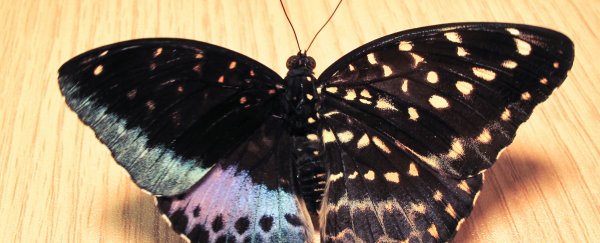A rare butterfly with wings exhibiting male and female markings has been found by volunteers at Drexel University in Philadelphia, US.
While preparing for an annual butterfly exhibit, volunteer Chris Johnson noticed unusual markings on the wings of a butterfly, which had emerged just hours before from its chrysalis.
"It slowly opened up, and the wings were so dramatically different, it was immediately apparent what it was," Johnson said in a press release.
The right wings were slightly larger, and were brown with yellowish spots, characteristic of the females of its species. The left wings, meanwhile, were characteristic of the males. They were smaller, darker, and had a shimmering green, blue and purple colouring along their bottoms.
"I thought: 'Somebody's fooling with me. It's just too perfect,'" Johnson said. "Then I got goose bumps."
The butterfly was turned over to the university's Entomology Collection Manager, Jason Weintraub, and an expert later confirmed that it was a Common Archduke (Lexias pardalis) butterfly, with a condition known as bilateral gynandromorphy.
This condition is most commonly found in insects, particularly butterflies, but has also been reported in crustaceans, such as lobsters, as well as in birds. It can usually only be spotted where the females and males have very different colouration, or some other distinct physical feature. (Check out this gallery of dual-sex animals).
A gynandromorph can have bilateral symmetry, meaning one side is male and the other female (like the butterfly found at Drexler University) or it can have mosaic patterning.
As Tanya Lewis at LiveScience points out , the condition differs from "hermaphroditism, in which an organism has both male and female reproductive organs, but has external characteristics of one gender."
Although gynandromorphism is considered quite rare, it's hard to estimate with certainty the rate of occurrence. This is because the condition can be easily overlooked in species where males and females look similar.
Bilateral gynandromorphy is usually caused by an atypical cell division in the early development of an organism, where the sex chromosomes fail to separate .
As a result of this atypical cell division, some cells will have a female genotype - lending to the development of female features - and others will have a male genotype.
The Common Archduke butterfly, which is found throughout Southeast Asia, is known for exhibiting strong sexual dimorphism - that means males and females have starkly different wing colouring and patterns.
Physical differences between the males and females of a given species are the result of an evolutionary process known as sexual selection. Coined by Charles Darwin, the process suggests these traits arise to help organisms attract mates in order to maximise their reproductive success. The traits of successful organisms are then passed down to future generations.
According to the Drexler University press release, this particular butterfly was shipped in October as one pupa (this term refers to the lifecycle stage of a butterfly undergoing transformation) among many from a sustainable butterfly farm on Penang Island in Malaysia.
The butterfly was preserved and pinned, and will be on display at the university's butterfly exhibit beginning later this month.
SOURCE: Drexler University
